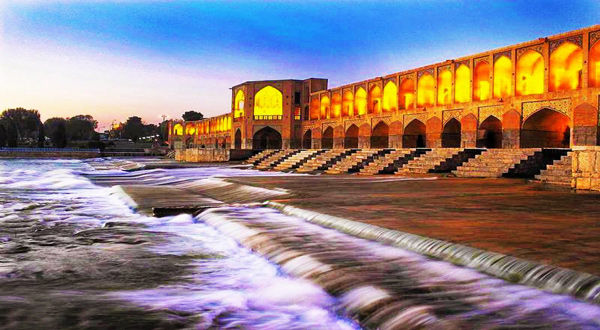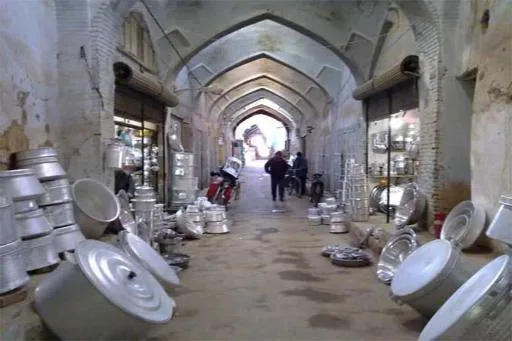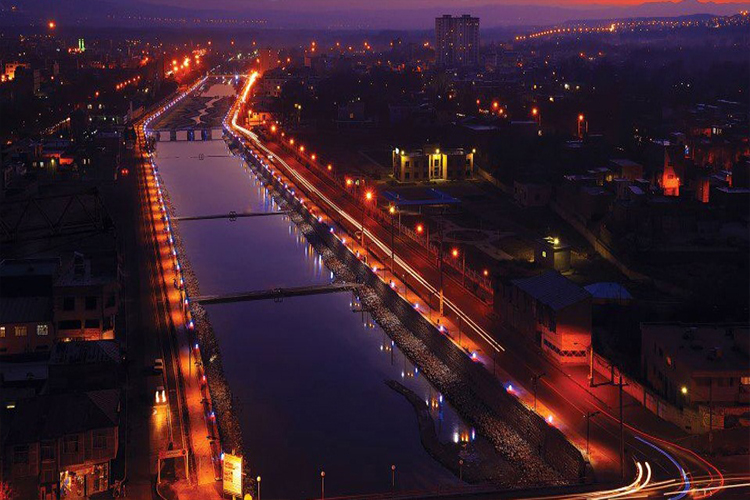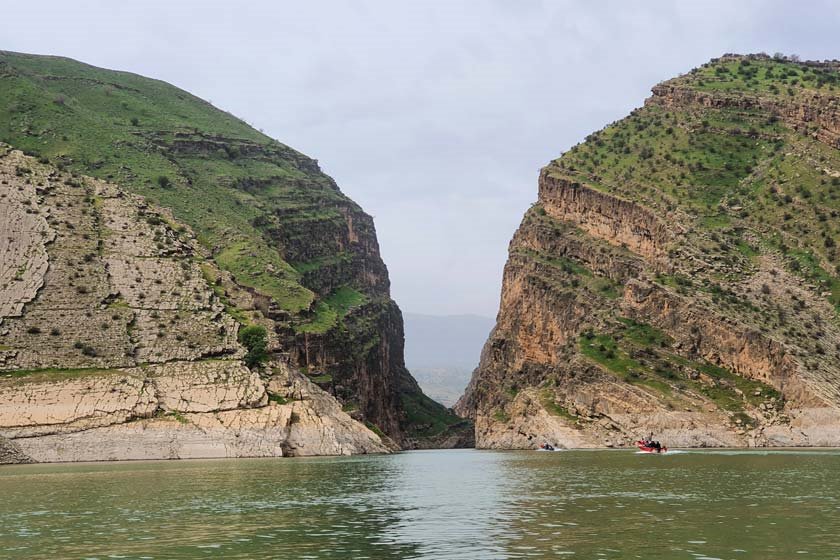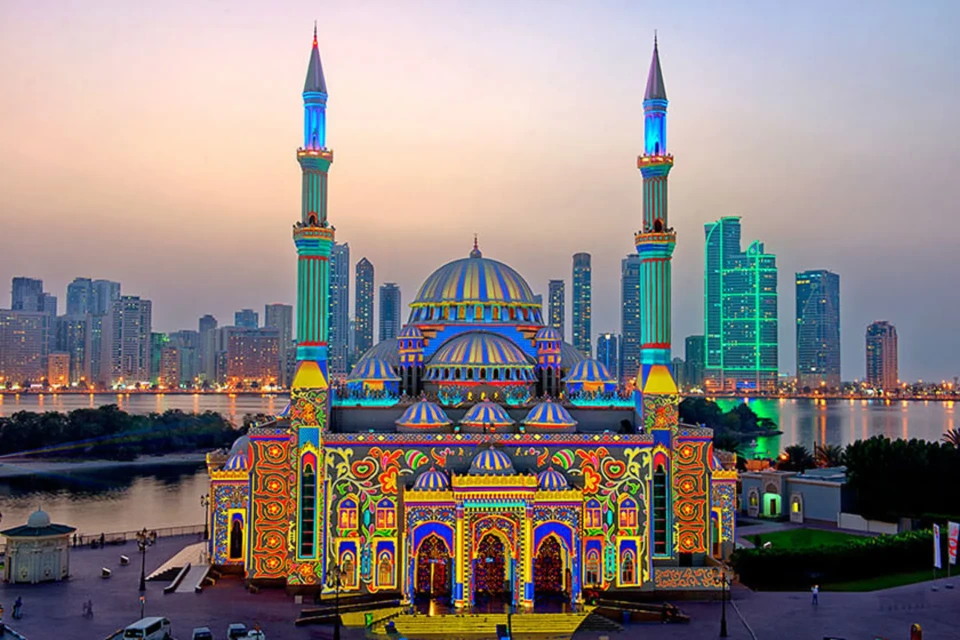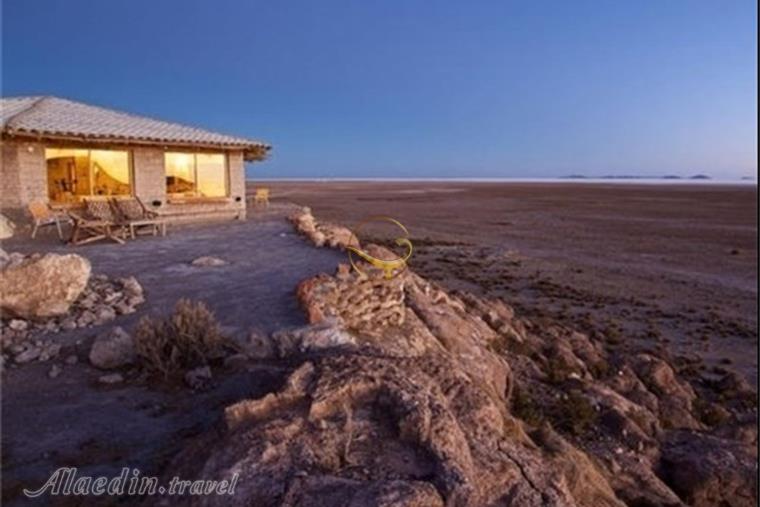Zayandeh Rood Esfahan- From the beginning until now
Zayandeh Rood, meaning “life-giving river” in Persian, is a historic and culturally significant waterway that flows through the heart of Isfahan, Iran. Spanning approximately 400 kilometers, this meandering river originates in the Zagros Mountains and plays a pivotal role in shaping the landscape and identity of Isfahan.
With its waters coursing through the city, Zayandeh Rood has witnessed centuries of history, serving as a vital source of sustenance for agriculture, a conduit for trade and transportation, and a canvas for architectural masterpieces. The river is adorned by iconic bridges, such as Si-o-se-pol and Khaju Bridge, each telling a story of craftsmanship and cultural heritage.
Zayandeh Rood is not merely a geographical feature but a symbol deeply embedded in the cultural fabric of Isfahan. It has inspired legends and folklore, depicting the river as both a giver of life and a mystical realm inhabited by water sprites.
However, the river faces contemporary challenges, including reduced water flow and environmental changes. Conservation efforts are underway to preserve the historical and ecological value of Zayandeh Rood, ensuring its continued role as a lifeblood for Isfahan and a source of inspiration for generations to come. Explore the enchanting tale of Zayandeh Rood, where history, culture, and nature converge along the banks of this timeless river.

What is Zayandeh Rood?
Zayandeh Rood, also known as Zayanderud or Zayandeh River, is the largest river in the central plateau of Iran. The name “Zayandeh Rood” translates to “Life-giving River” in Persian. It has played a significant role in the cultural and historical development of the region, particularly in the city of Isfahan.
Here are some key features and aspects of Zayandeh Rood:
Geography:
Zayandeh Rood originates in the Zagros Mountains and flows eastward through the provinces of Chaharmahal and Bakhtiari, Esfahan, and Yazd. It covers a total length of approximately 400 kilometers.
Flow Through Isfahan:
Zayandeh Rood passes through the city of Isfahan, one of Iran’s most famous and historically rich cities. The river has been a vital element in the development and sustenance of Isfahan’s urban landscape.
Bridges:
Isfahan is renowned for its beautiful bridges that span Zayandeh Rood. Some of the notable ones include Si-o-se-pol (Bridge of 33 Arches) and Khaju Bridge. These bridges not only serve practical purposes but also contribute to the architectural beauty of the city.
Historical Significance:
Zayandeh Rood has played a crucial role in the historical development of Isfahan, providing water for agriculture, enabling trade and transportation, and influencing the city’s architectural layout.
Cultural Importance:
The river has become an integral part of Isfahan’s culture and has inspired literature, poetry, and art throughout the centuries.
Ecological Impact:
Zayandeh Rood supports the local ecosystem, providing water for vegetation and serving as a habitat for various species of plants and animals.
Water Management Challenges:
In recent years, the river has faced challenges related to water scarcity and mismanagement, leading to periods of reduced water flow. Dams and water diversion projects upstream have contributed to fluctuations in the river’s water levels.
Recreational Use:
Zayandeh Rood has been a popular spot for recreational activities, including boat rides and picnics along its banks. However, the availability of these activities can be affected by the river’s water levels.
Conservation Efforts:
Efforts have been made to address the environmental challenges facing Zayandeh Rood, including initiatives to improve water management and promote conservation.
In summary, Zayandeh Rood is a historically and culturally significant river in Iran, and its presence has shaped the development of Isfahan and the surrounding region over the centuries. The river’s cultural, ecological, and economic importance makes it a prominent feature in the landscape of central Iran.
Where is Zayandeh Rood located in Isfahan?
Zayandeh Rood flows through the city of Isfahan in central Iran. The river is a central feature of Isfahan’s landscape, and several historic bridges span its waters, enhancing the city’s architectural beauty. Some of the prominent bridges over Zayandeh Rood in Isfahan include Si-o-se-pol (Bridge of 33 Arches) and Khaju Bridge.
Isfahan, one of Iran’s most famous and historically significant cities, has been greatly influenced by the presence of Zayandeh Rood. The river contributes to the city’s cultural heritage, providing water for agricultural purposes, supporting trade and transportation, and adding to the overall charm of Isfahan’s urban environment. The specific location of Zayandeh Rood within Isfahan can be traced by following its path through the city, passing under various bridges and contributing to the city’s picturesque scenery.
What is the significance of Zayandeh Rood in Isfahan’s history?
Zayandeh Rood holds immense historical significance in the city of Isfahan, playing a pivotal role in its development and cultural heritage. Here are several aspects highlighting the importance of Zayandeh Rood in Isfahan’s history:
Water Supply and Agriculture:
Zayandeh Rood has been a vital water source for Isfahan, supporting agriculture and enabling the cultivation of crops in the surrounding areas. The river’s waters have historically been channeled through a network of canals to irrigate fields, contributing to the city’s agricultural prosperity.
Trade and Transportation:
The river facilitated trade and transportation, serving as a natural route for the movement of goods and people. Isfahan’s strategic location along the banks of Zayandeh Rood made it a significant center for commerce and cultural exchange.
Urban Development:
The city’s urban layout has been influenced by the presence of Zayandeh Rood. Historical bridges, such as Si-o-se-pol and Khaju Bridge, not only served practical purposes but also became iconic architectural features, contributing to the city’s aesthetic appeal.
Cultural and Architectural Heritage:
Zayandeh Rood has inspired artists, poets, and writers throughout history. Its scenic beauty, along with the bridges and gardens along its banks, has been celebrated in literature, paintings, and other forms of artistic expression.
Recreational and Social Spaces:
The river and its banks have been important recreational spaces for the residents of Isfahan. People have traditionally engaged in activities such as boating, picnicking, and socializing along the river.
Symbolic Importance:
Zayandeh Rood is not just a physical feature but also holds symbolic importance in the cultural identity of Isfahan. The river is often referenced in local folklore, poetry, and traditions.
Architectural Masterpieces:
The bridges over Zayandeh Rood, such as Si-o-se-pol and Khaju Bridge, are not only practical structures but also architectural masterpieces. They showcase the skill and artistry of the craftsmen and engineers of their respective eras.
Environmental Impact:
The river has contributed to the local ecosystem, supporting various plant and animal species along its banks.
Challenges and Conservation:
In recent years, the river has faced challenges such as reduced water flow due to factors like climate change and human activities. Conservation efforts have been initiated to address these challenges and preserve the historical and ecological value of Zayandeh Rood.
In summary, Zayandeh Rood has been a central and multi-faceted element in Isfahan’s history, influencing its economic, cultural, and architectural development over the centuries. The river continues to be a symbol of the city’s rich heritage and a source of inspiration for its residents and visitors alike.

What is the significance of Zayandeh Rood in Isfahan’s history?
Zayandeh Rood holds great significance in the history of Isfahan, contributing to the city’s development, culture, and identity in various ways. Here are some key aspects of the river’s significance in Isfahan’s history:
Water Supply and Agriculture:
Zayandeh Rood has been a crucial water source for Isfahan, supporting agriculture in the region. The river’s waters have historically been used for irrigation, allowing for the cultivation of crops and contributing to the city’s agricultural prosperity.
Urban Development:
The layout of Isfahan has been influenced by the presence of Zayandeh Rood. The river has played a role in shaping the city’s architecture and infrastructure, with bridges and embankments enhancing the urban landscape.
Historical Bridges:
Isfahan is famous for its historical bridges that span Zayandeh Rood. Bridges like Si-o-se-pol (Bridge of 33 Arches) and Khaju Bridge are not only functional but also architectural marvels that have become iconic symbols of the city.
Trade and Transportation:
Zayandeh Rood served as a natural waterway for trade and transportation. The river facilitated the movement of goods and people, contributing to Isfahan’s role as a cultural and economic hub.
Cultural Symbolism:
The river has symbolic significance in Isfahan’s culture and identity. References to Zayandeh Rood are found in local folklore, poetry, and art, reflecting the emotional and cultural connection that the people of Isfahan have with the river.
Recreational and Social Space:
Zayandeh Rood and its surrounding areas have traditionally been important recreational spaces for the residents of Isfahan. People engage in activities such as boat rides, picnics, and leisurely strolls along the riverbanks.
Environmental Impact:
The river has contributed to the local ecosystem, providing a habitat for various flora and fauna along its course.
Cultural Heritage:
Zayandeh Rood has been a source of inspiration for artists, poets, and writers throughout history. The river’s beauty and the ambiance created by its bridges and gardens have been celebrated in cultural and artistic expressions.
Challenges and Conservation:
In recent years, the river has faced challenges related to reduced water flow due to factors like climate change and human activities. Efforts have been made to address these challenges, including water management initiatives and conservation projects, to preserve the historical and ecological value of Zayandeh Rood.
In summary, Zayandeh Rood is not just a geographical feature in Isfahan; it is an integral part of the city’s history, culture, and identity. The river’s role in supporting life, facilitating trade, inspiring art, and shaping the urban landscape has left a lasting impact on the development of Isfahan.
How long is Zayandeh Rood?
Zayandeh Rood is approximately 400 kilometers (about 250 miles) long. The river originates in the Zagros Mountains and flows eastward through the provinces of Chaharmahal and Bakhtiari, Esfahan, and Yazd in central Iran. Its length makes it the largest river in the central plateau of Iran, and it has historically played a significant role in the development and sustenance of the regions through which it passes, particularly in Isfahan.
What are the main attractions along Zayandeh Rood?
Zayandeh Rood, especially as it flows through the city of Isfahan, is surrounded by various attractions and landmarks. Here are some of the main attractions along Zayandeh Rood:
Si-o-se-pol (Bridge of 33 Arches):
Si-o-se-pol is one of the most famous bridges in Isfahan, spanning Zayandeh Rood. It features 33 arches and is a popular site for both locals and tourists. The bridge has historical and architectural significance, providing stunning views of the river and the city.
Khaju Bridge:
Khaju Bridge is another iconic bridge over Zayandeh Rood. It is known for its beautiful tilework and symmetrical design. The bridge has a dual function, serving as a bridge and a dam. It also has pavilions and spaces for social gatherings.
Pol-e Shahrestan (Shahrestan Bridge):
Shahrestan Bridge is one of the oldest bridges in Isfahan, dating back to the Sasanian era. It has undergone various renovations throughout history and provides a historic link across Zayandeh Rood.
Zayandeh Rood Riverwalk:
The riverbanks of Zayandeh Rood offer scenic walking paths, providing a peaceful and relaxing environment. Locals and visitors often take leisurely strolls along the river, enjoying the views and greenery.
Marnan Bridge:
Marnan Bridge is known for its historical significance and unique architectural style. It is a pedestrian bridge with distinct arches and provides a picturesque setting over Zayandeh Rood.
Zayandeh Rood Flower Garden:
This garden along the riverbanks is a popular spot for locals and tourists. It features vibrant flowers, greenery, and pathways, creating a tranquil atmosphere for visitors.
Chahar Bagh Boulevard:
Chahar Bagh Boulevard runs alongside Zayandeh Rood and is a grand avenue lined with trees, gardens, and historic buildings. It adds to the overall charm of the river’s surroundings.
Isfahan Bird Garden:
Located near Zayandeh Rood, this garden is dedicated to various bird species. It provides an opportunity for visitors to observe and learn about different birds in a natural setting.
Isfahan’s Historical Bridges Exhibition:
This exhibition, located on the Zayandeh Rood’s eastern bank, showcases the history and architectural details of Isfahan’s historic bridges. It offers insights into the engineering and cultural aspects of these structures.
Hasht Behesht Palace:
While not directly on the river, Hasht Behesht Palace is located near the eastern bank of Zayandeh Rood. It is a historical Persian garden with a pavilion, adding to the cultural and architectural richness of the area.
These attractions contribute to the overall appeal of Zayandeh Rood, making it a central and vibrant part of Isfahan’s cultural and historical landscape.
Is there a bridge over Zayandeh Rood in Isfahan?
Yes, Isfahan is renowned for its beautiful historic bridges that span the Zayandeh Rood river. Some of the notable bridges over Zayandeh Rood in Isfahan include:
Si-o-se-pol (Bridge of 33 Arches):
Si-o-se-pol is a famous bridge with 33 arches, spanning Zayandeh Rood. It is one of the iconic landmarks of Isfahan and provides breathtaking views of the river. The bridge serves as both a pedestrian walkway and a dam.
Khaju Bridge:
Khaju Bridge is another significant bridge over Zayandeh Rood. It is known for its beautiful tilework and intricate design. Khaju Bridge has multiple functions, serving as a bridge, a dam, and a place for social gatherings.
Pol-e Shahrestan (Shahrestan Bridge):
Shahrestan Bridge is one of the oldest bridges in Isfahan, dating back to the Sasanian era. Although it has undergone renovations over the centuries, it retains its historical charm and connects the two banks of Zayandeh Rood.
These bridges not only provide practical crossings over the river but also contribute to the architectural and cultural identity of Isfahan. They are important historical and aesthetic landmarks, attracting visitors who admire their design and enjoy the scenic views of Zayandeh Rood from these structures.
How does Zayandeh Rood contribute to Isfahan’s ecosystem?
Zayandeh Rood plays a significant role in contributing to Isfahan’s ecosystem in various ways:
Water Source for Flora and Fauna:
The river provides a vital water source for the vegetation along its banks, sustaining a diverse array of plant species. The availability of water supports the growth of trees, shrubs, and other plant life, creating a green corridor along Zayandeh Rood.
Habitat for Wildlife:
Zayandeh Rood serves as a habitat for various wildlife species. Birds, fish, and other aquatic animals are dependent on the river for their survival. The riverbanks and surrounding areas provide nesting grounds and shelter for a diverse range of fauna.
Biodiversity Support:
The presence of a flowing river contributes to the overall biodiversity of the region. The diverse ecosystem along Zayandeh Rood helps maintain a balance in the natural environment.
Erosion Control:
The river’s flow and the vegetation along its banks play a role in controlling soil erosion. The roots of plants help stabilize the soil, preventing erosion and maintaining the integrity of the riverbanks.
Water for Agricultural Practices:
Zayandeh Rood has historically been a crucial water source for agricultural activities in the Isfahan region. Irrigation from the river supports the cultivation of crops, contributing to the local economy and food production.
Scenic Beauty and Tourism:
The natural beauty of Zayandeh Rood and its surroundings enhances the appeal of Isfahan as a tourist destination. The scenic views of the river, combined with historic bridges and gardens, contribute to the city’s cultural and aesthetic charm.
Cultural Significance:
The river has cultural importance in the region, and its role in sustaining life and ecosystems is reflected in local traditions, folklore, and art. This cultural connection helps foster an appreciation for environmental conservation.
Recreational Opportunities:
Zayandeh Rood provides recreational opportunities for residents and visitors. People engage in activities such as boating, picnicking, and leisurely walks along the riverbanks, promoting a connection between the community and the natural environment.
It’s important to note that the ecosystem along Zayandeh Rood faces challenges, including issues related to water scarcity, pollution, and changes in land use. Efforts to address these challenges and implement sustainable water management practices are crucial for preserving the river’s ecological contributions to Isfahan and the surrounding region.
Is Zayandeh Rood used for recreational activities?
Yes, Zayandeh Rood is used for various recreational activities, providing both locals and visitors with opportunities to enjoy the natural beauty of the river and its surroundings. Some common recreational activities along Zayandeh Rood in Isfahan include:
Boating:
Boating is a popular recreational activity on Zayandeh Rood. Visitors can rent boats and enjoy a leisurely ride along the river, taking in the scenic views and the architecture of the historic bridges.
Picnicking:
The riverbanks of Zayandeh Rood provide peaceful and picturesque settings for picnics. Families and friends often gather along the river to enjoy outdoor meals, relax, and socialize.
Walking and Jogging:
The pathways along the riverbanks are suitable for walking, jogging, and cycling. Residents and tourists take advantage of these paths for exercise and to experience the natural beauty of Zayandeh Rood.
Photography:
Zayandeh Rood, with its historic bridges and scenic landscapes, is a popular spot for photography. Visitors capture the beauty of the river, the reflections in the water, and the architectural details of the bridges.
Cafes and Restaurants:
There are cafes and restaurants located along the riverbanks, providing a pleasant atmosphere for people to enjoy a meal or a cup of tea while overlooking Zayandeh Rood.
Social Gatherings:
The riverside areas, especially near the historic bridges like Si-o-se-pol and Khaju Bridge, are popular places for social gatherings. People gather to enjoy the surroundings, engage in conversations, and experience the vibrant atmosphere.
Festivals and Events:
Occasionally, festivals and cultural events take place along Zayandeh Rood, attracting larger crowds. These events may include music performances, art exhibitions, or celebrations that utilize the scenic backdrop of the river.
While Zayandeh Rood offers various recreational opportunities, it’s important to note that the availability of certain activities may be influenced by factors such as the river’s water levels, which can fluctuate based on environmental conditions and water management practices. Nonetheless, the river continues to be an integral part of Isfahan’s recreational and cultural landscape.
Are there any festivals or events associated with Zayandeh Rood?
Zayandeh Rood and its surroundings have been the backdrop for various festivals and events in Isfahan. While specific events can change over time, here are some types of festivals and events that might be associated with Zayandeh Rood:
Cultural and Arts Festivals:
Isfahan, being a city rich in cultural heritage, occasionally hosts festivals celebrating local arts, crafts, music, and literature. The scenic views along Zayandeh Rood may serve as venues for cultural performances and exhibitions.
Environmental Awareness Events:
Given the importance of Zayandeh Rood to the local ecosystem, there might be events focused on environmental conservation, raising awareness about water management, and promoting sustainable practices.
Music and Performance Events:
The riverbanks, especially near historic bridges, could be locations for outdoor music festivals, concerts, or theatrical performances, taking advantage of the picturesque setting.
Riverfront Markets:
Seasonal markets or bazaars might be organized along the river, showcasing local crafts, artwork, and traditional goods. These events can contribute to the cultural and economic vibrancy of the area.
Sports Events:
The riverbanks and surrounding areas may host sports events or competitions, including marathons, rowing competitions, or other water-based sports activities.
New Year’s Celebrations:
Zayandeh Rood and its bridges are sometimes lit up during Nowruz, the Iranian New Year, and the city may organize events and festivities along the riverbanks.
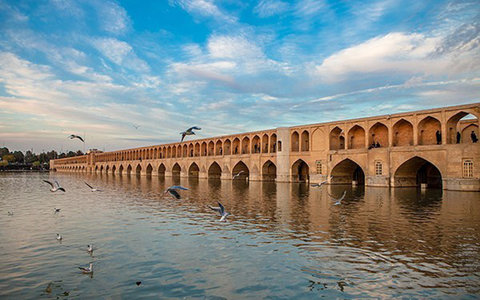
Water-related Celebrations:
Given the historical and cultural significance of Zayandeh Rood as a life-giving river, there might be ceremonies or celebrations related to water, reflecting its importance in sustaining life.
It’s important to note that the specific events can vary from year to year, and local authorities or event organizers typically announce the schedule and details closer to the date. If you’re planning to visit Isfahan and are interested in events along Zayandeh Rood, it’s advisable to check with local tourism offices, event organizers, or official city websites for the most current information on festivals and events in the area.
How can visitors access Zayandeh Rood in Isfahan?
Visitors to Isfahan can access Zayandeh Rood through various means, and the river is easily accessible from different parts of the city. Here are common ways visitors can reach Zayandeh Rood:
City Center:
The central areas of Isfahan, where many of the historical sites and attractions are located, are typically close to the river. Visitors can walk or take short rides to reach the riverbanks.
Historical Bridges:
Some of the most famous historical bridges over Zayandeh Rood, such as Si-o-se-pol and Khaju Bridge, are easily accessible from the city center. These bridges provide excellent vantage points for enjoying the river views.
Chahar Bagh Avenue:
Chahar Bagh Avenue is a major street in Isfahan that runs parallel to Zayandeh Rood. Visitors can access the river by walking along or crossing Chahar Bagh Avenue.
Public Transportation:
Isfahan has a public transportation system, including buses and taxis, that can take visitors to various parts of the city, including areas along Zayandeh Rood.
Walking or Cycling:
Isfahan is known for its pedestrian-friendly streets. Visitors can explore the city on foot or rent bicycles to reach the riverbanks and enjoy a leisurely ride along Zayandeh Rood.
Local Guides:
Local guides or tourist information centers in Isfahan can provide directions and assistance to visitors looking to access Zayandeh Rood. They may also offer insights into the best spots along the river.
Hotels and Accommodations:
Many hotels and guesthouses in Isfahan are located within proximity to Zayandeh Rood. Visitors staying in accommodations near the city center are likely to have convenient access to the river.
Taxi or Ride-Sharing Services:
Taxis and ride-sharing services are available in Isfahan and can be used to reach specific points along Zayandeh Rood.
Once at Zayandeh Rood, visitors can explore the riverbanks, enjoy the views of the historical bridges, and partake in various recreational activities available in the area.
It’s advisable for visitors to obtain a local map or use navigation apps for guidance, and to ask locals or tourism information centers for specific directions based on their starting point in Isfahan.
Is swimming allowed in Zayandeh Rood?
“Due to the government’s incapacity and mismanagement, the Zayandeh Rud River in Iran has currently dried up, and there may be minimal water flow during certain times of the year.””With the presence of water in the Zayandeh Rud River, it can be said that swimming in it depends on the following factors:”
Water Quality: The water quality in urban rivers, including Zayandeh Rood, can be affected by various factors such as pollution and urban runoff. Swimming in rivers with uncertain water quality poses health risks.
Water Flow and Depth: The flow and depth of Zayandeh Rood can vary, and there may be areas with strong currents or submerged hazards. These conditions make swimming unsafe without proper monitoring and supervision.
Cultural and Safety Concerns: Zayandeh Rood is a culturally significant river, and the historical bridges and surrounding areas are popular for recreational activities. However, swimming in the river may pose safety risks, and there might be cultural or local regulations discouraging such activities.
It’s crucial for visitors to adhere to any posted signs, follow local regulations, and prioritize their safety and the preservation of the environment. If there have been changes in regulations or local policies since my last update, I recommend checking with local authorities, tourism offices, or signage at the riverbanks for the most current information on swimming in Zayandeh Rood.
What efforts are being made to preserve Zayandeh Rood?
Preserving Zayandeh Rood is a significant concern due to environmental challenges, including water scarcity, fluctuations in water flow, and the impact of human activities. Various efforts and initiatives have been undertaken to address these issues and conserve the river. Some of the key conservation efforts include:
Water Management Strategies:
Implementing effective water management strategies is essential to ensure a sustainable and consistent flow of water in Zayandeh Rood. This may involve the construction of dams, reservoirs, and irrigation systems to regulate water distribution.
Environmental Monitoring:
Regular monitoring of water quality, ecosystem health, and the overall environmental conditions of Zayandeh Rood is crucial. This monitoring helps identify potential threats and allows for informed decision-making in conservation efforts.
Restoration Projects:
Restoration projects aim to rehabilitate the natural habitat along Zayandeh Rood. These projects may involve planting native vegetation, removing invasive species, and addressing erosion to enhance the overall health of the river ecosystem.
Community Involvement:
Engaging the local community in conservation efforts is vital. Community participation can include awareness campaigns, educational programs, and involving residents in activities such as river cleanups and tree planting.
Water Conservation Campaigns:
Promoting water conservation practices among residents, businesses, and industries is essential for ensuring the sustainability of Zayandeh Rood. This may involve campaigns encouraging responsible water use and reducing pollution.
Legislation and Regulation:
Implementing and enforcing environmental regulations and legislation is critical for protecting Zayandeh Rood. These regulations may address issues such as water extraction, industrial discharges, and land use practices that affect the river.
International Collaboration:
Given that rivers often span multiple regions and countries, international collaboration is important for addressing transboundary water management issues. Collaborative efforts can involve sharing data, coordinating conservation projects, and fostering dialogue among stakeholders.
Scientific Research:
Ongoing scientific research helps improve our understanding of the ecological dynamics of Zayandeh Rood. Research findings can inform conservation strategies and provide insights into mitigating environmental challenges.
Drought Management:
Developing and implementing drought management plans is crucial for addressing periods of water scarcity. These plans may involve water rationing, promoting efficient irrigation practices, and implementing measures to mitigate the impact of droughts on the river.
Tourism Management:
Implementing sustainable tourism practices along Zayandeh Rood helps minimize the ecological impact of visitors. This may include responsible tourism guidelines, infrastructure development that minimizes environmental impact, and regulating recreational activities.
It’s important to note that conservation efforts are ongoing, and their success often depends on the collaboration of various stakeholders, including government agencies, non-governmental organizations, local communities, and the public. Regular assessments and adaptive management strategies are crucial for the continued preservation of Zayandeh Rood and its surrounding ecosystem.
Can you take boat tours on Zayandeh Rood?
boat tours on Zayandeh Rood have been offered as a recreational activity in Isfahan, particularly in the areas near the historic bridges such as Si-o-se-pol and Khaju Bridge. However, the availability of boat tours can be influenced by factors such as water levels, seasonal variations, and local regulations.
Boat tours on Zayandeh Rood typically provide visitors with a unique perspective of the river and its surroundings, allowing them to enjoy the scenic views and architectural beauty of the historic bridges from the water.
To find out about the current status of boat tours on Zayandeh Rood and to make arrangements, I recommend checking with local tourism offices, tour operators, or boat rental services in Isfahan. These sources can provide up-to-date information on the availability of boat tours, any seasonal restrictions, and safety guidelines.
Are there any legends or folklore associated with Zayandeh Rood?
Yes, Zayandeh Rood has been the subject of various legends, folklore, and cultural stories in the region. These stories often highlight the river’s historical, cultural, and symbolic significance. Here are a couple of examples:
The Legend of the Water Sprite (Parik):
One popular legend associated with Zayandeh Rood involves a mythical creature known as a “Parik” or water sprite. According to the legend, the Parik would emerge from the river at night and roam the riverbanks. It is said that the Parik possessed magical powers and could grant wishes to those who encountered it. This folklore adds a mystical and enchanting aspect to the river’s cultural significance.
The Tale of Zayandeh Rood as a Source of Life:
Zayandeh Rood’s name itself carries a significant meaning. “Zayandeh” translates to “life-giving” in Persian. The river has historically been crucial for agriculture, providing water for irrigation and sustaining life in the region. Folklore may emphasize the river’s role as a benevolent force that nourishes the land and contributes to the well-being of the community.
Historical Legends:
Some legends and stories associated with Zayandeh Rood may be rooted in historical events and figures. For instance, tales of battles fought along the riverbanks or the construction of the historic bridges over the centuries can become part of local folklore, emphasizing the river’s role in shaping the history of Isfahan.
Cultural Symbolism:
Zayandeh Rood has symbolic importance in Persian literature and poetry. Poets and writers often use the river as a metaphor in their works, drawing on its flowing waters and historical bridges to convey themes of life, love, and the passage of time.
These legends and folklore contribute to the cultural identity of Isfahan and the surrounding region. They reflect the deep connection between the local community and the river, highlighting the role of Zayandeh Rood as not only a physical entity but also a source of inspiration, mystique, and cultural richness.

